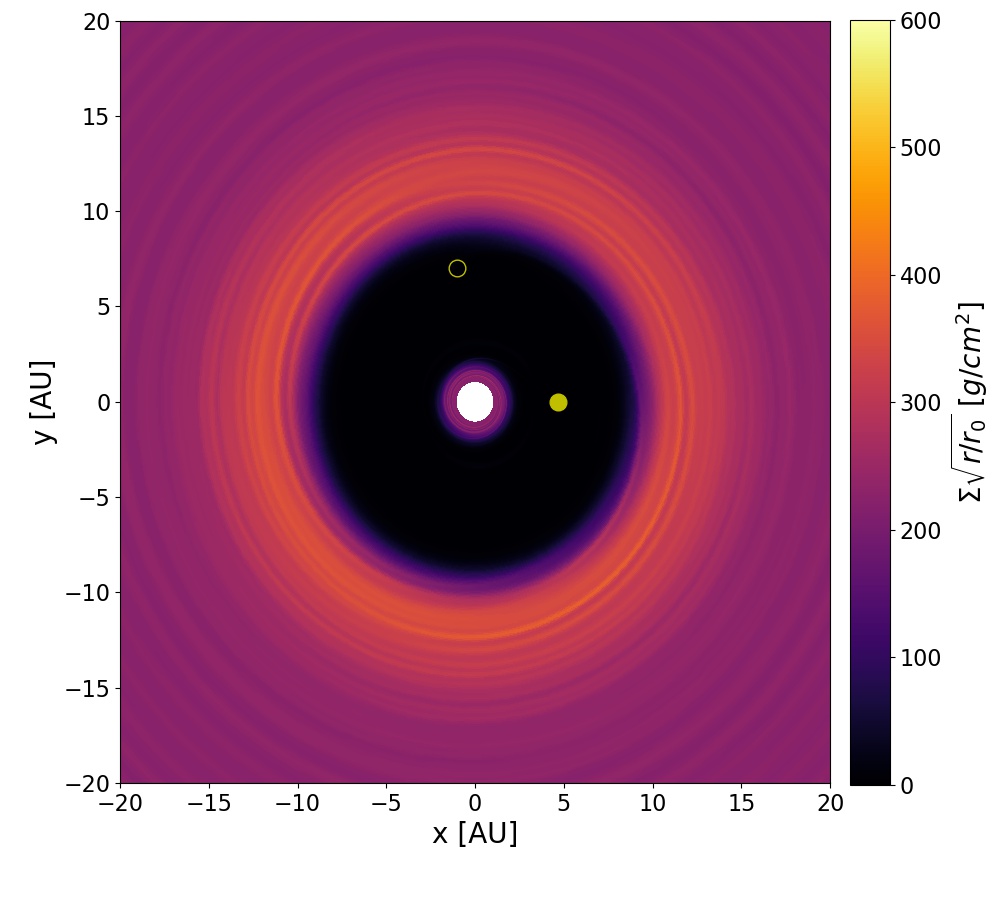Minimal viscosity discs lock pairs of giant planets in 2:1 resonance with stalled migration.
- Universite Cote d'Azur, Observatoire de la Cote d'Azur, Lagrange, France (philippine.griveaud@oca.eu)
Planets form in protoplanetary discs and their interactions with the gas give rise to migration. For a long time, discs were believed to have a non-negligible viscosity to justify the high accretion rates of gas onto the central star. However, it has recently been shown observationally and theoretically that protoplanetary discs are probably much less viscous than previously thought. In our study, we use a new paradigm for the theoretical modelling of discs where the accretion onto the central star is done through the superficial layers while the mid-plane has a close to zero viscosity (Lega et al. 2022). In such discs, the migration of a single giant planet differs from the classical Type-II migration regime and depends on the thickness of the accretion layer. It is therefore interesting to consider the migration of a pair of giant planets in this new model. We have started this project, in the simplified framework of 2D hydrodynamical simulations (using the code FARGOCA) with an α viscosity parameter of 10−5 (in the standard Shakura & Sunyaev 1973 viscosity parametrization). We first consider a pair of Jupiter and Saturn mass planets, then extend our study to a wider range of planetary masses.
In classical viscous discs (corresponding to an α=10−3), Jupiter and Saturn systems are most often locked in the 3:2 mean motion resonance and may migrate outwards. Instead in our case (α=10−5), we find that the pair of planets gets locked in the 2:1 resonance and has a stalled or slightly inward migration. We confirmed this result for a range of disc masses and thicknesses as well as different starting positions of Saturn. This result is also independent of the mass of the outer planet. In order to explain our result, we have a used a criterion for resonance crossing based on Batygin, 2015 . Unlike in classical discs, a planet growing and migrating in a low viscosity disc does not reach the migration speed required to cross the 2:1 MMR. The only case in which outward migration is observed, is the "ad-hoc" scenario where Saturn would form inside the 2:1 resonance and get locked in the 3:2. However, owing to the large width of Jupiter's gap, this scenario seems unlikely.
If the Solar System formed from such a low-viscosity disc, this result has strong implications for the Grand Tack and Nice models, which both assume Jupiter and Saturn to be inside the 2:1 resonance. The stalled migration could, however, explain the so called warm-Jupiters population among the detected exoplanets, providing that these are in multi-planet systems. Additionally, we remark that the only system with two giant planets observed in a disc of gas, namely PDS70, occurs to be close to the 2:1 resonance.

Figure 1: Surface density of a 2D simulation after nearly 300 000 years of evolution, displaying Jupiter (filled circle) and Saturn (empty circle) in their common gap. The planets are stably locked in the 2:1 mean motion resonance and are following a very slow inward migration at a speed of one a.u. per million years.
References:
E. Lega et al., “Migration of Jupiter Mass Planets in Discs with Laminar Accretion Flows,” Astronomy & Astrophysics 658 (2022)
Konstantin Batygin, “Capture of Planets into Mean-Motion Resonances and the Origins of Extrasolar Orbital Architectures,” Monthly Notices of the Royal Astronomical Society 451, no. 3 (August 11, 2015)
How to cite: Griveaud, P., Crida, A., and Lega, E.: Minimal viscosity discs lock pairs of giant planets in 2:1 resonance with stalled migration., Europlanet Science Congress 2022, Granada, Spain, 18–23 Sep 2022, EPSC2022-464, https://doi.org/10.5194/epsc2022-464, 2022.

